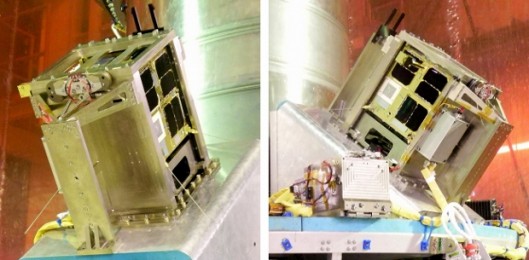At the Satish Dhawan Space Centre in Sriharikota, India this morning (Feb. 25), the smallest astronomical satellite ever built was launched into orbit aboard the Polar Satellite Launch Vehicle C20 rocket. In fact, it wasn’t just one satellite, but two – each of the twin BRIght Target Explorer (BRITE) spacecraft take the form of a cube that measures just 20 cm (7.8 inches) per side, and weighs in at under seven kilograms (15.4 lbs).
The BRITEs were designed at the Space Flight Laboratory (SFL) of the University of Toronto Institute for Aerospace Studies. One of the two nano-satellites launched today, known as UniBRITE, was assembled at SFL and funded by the University of Vienna. The other, called BRITE-Austria, was assembled in Austria and funded by that country’s Technical University of Graz – it is being promoted as “Austria’s First Satellite.”
Once in orbit, the satellites will work together to monitor changes in brightness of some of the largest, brightest stars in the sky. Their relatively small onboard telescopes limit their ability to monitor dimmer stars, or to take “pretty pictures.” Unlike ground-based telescopes that could be used to view those same stars, however, the satellites won’t be limited by scintillation – the visual distortion of celestial bodies, created by turbulence in the Earth’s atmosphere. They will also be able to image their target stars day and night, and won’t be thwarted by weather conditions such as cloud cover.
Because such large stars oscillate more slowly than smaller ones, the satellites won’t have to monitor them continuously. Instead, they can just check in on the stars at regular intervals, taking note of what changes in brightness have occurred. This, in turn, means that the satellites don’t need to be placed in one “right” orbit, where they can see their chosen star at all times. As a result, future BRITEs could hitch a ride into space on any available rocket, and placed into orbit wherever it was convenient – within reason.
Along with their telescopes, each of today’s two satellites contain three computers: one for instrument processing, one for housekeeping (keeping the satellite running), and one for attitude control. Approximately six watts of electrical power is provided by onboard solar cells.
Plans call for two other pairs of BRITE satellites to join the pair launched today, forming a “constellation” of six nano-satellites that will work together. Two of them will be Canadian, while two will be Austrian and two will be Polish.
“Big bright stars lead short and violent lives and deaths (supernovas) and in the process seed the universe with heavy elements without which life on Earth would be impossible,” the University of Toronto stated in a press release. “To better understand these stars is to better understand how life arose on our planet.”
More information on the construction of the nano-satellites is available in the video below.
Source: Gizmag












